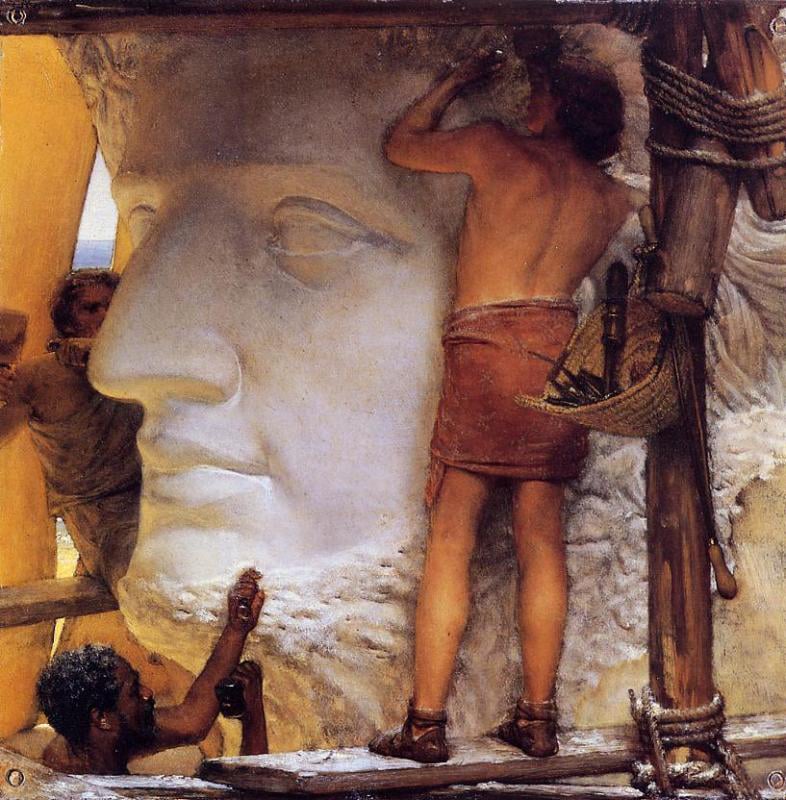The Colossus of Nero was a monumental bronze statue that stood about 30 to 37 meters (98 to 121 feet) tall. Nero commissioned it after the Great Fire of Rome in 64 CE, placing it in the vestibule of his vast new palace, the Domus Aurea, on the Velian Hill. The fire had destroyed much of the city, giving Nero an opportunity to rebuild Rome in his image.
Nero hired Zenodorus, a Greek architect, to design and oversee the construction of the colossus. Zenodorus was known for his work in Gaul, where he built a massive bronze statue of Mercury for the Arverni tribe. For Nero’s Colossus, Zenodorus built a brick and marble-faced foundation and employed an in-situ casting method, assembling the statue in sections directly on-site. Its structure was reinforced with a stone core and iron rods to support the huge bronze shell.
Construction began between 64 and 68 CE, but Nero’s death in 68 CE meant the statue was not completed as intended. After his downfall, the Senate condemned Nero’s memory and ordered the destruction of his statues. Vespasian, his successor, chose to rework the statue rather than destroy it. He added a radiate crown and rededicated it to Sol, the Roman sun god.
The statue remained an important landmark for centuries. During the reign of Hadrian, it was moved from the Velian Hill to a site next to the Flavian Amphitheatre, later known as the Colosseum, to make room for the Temple of Venus and Roma. Because the Colossus could not be dismantled, it was moved with the help of 24 elephants sometime between 126 and 128 CE.
Under Commodus, the statue was briefly altered to show the emperor as Hercules, complete with club and lion skin, but these changes were reversed after his death. The Colossus continued to stand until at least the mid-fourth century, when it was last mentioned in the Chronography of 354. It was probably toppled by an earthquake in the fifth century or destroyed during the sack of Rome in 410 CE.
Today, only the foundation of the Colossus survives. The bronze was almost certainly melted down for reuse long ago. Its cultural legacy, however, endures in the name of the Colosseum, which likely came from the amphitheater’s position beside the Colossus.
Bibliography:
- Albertson, Fred. (2001). “Zenodorus’ Colossus of Nero.” Memoirs of the American Academy in Rome 46: 95–118. http://www.jstor.org/stable/4238781
- Hannah, R., Magli, G., & Palmieri, A. (2016). “Nero’s ‘Solar’ Kingship and the Architecture of the Domus Aurea.” Numen, 63(5/6), 511–524. http://www.jstor.org/stable/44505307
- Platner, Samuel. (1929). “Colossus Neronis.” In A Topographical Dictionary of Ancient Rome (p.130-131). Retrieved from: https://penelope.uchicago.edu/Thayer/E/Gazetteer/Places/Europe/Italy/Lazio/Roma/Rome/_Texts/PLATOP*/Colossus_Neronis.html
Colossus Neronis: a colossal bronze statue of Nero, 120 feet high, the work of Zenodorus, a Greek, erected by Nero himself in the vestibule of the Domus Aurea (q.v.) on the summit of the Velia (Suet. Nero 31; Plin. NH XXXIV.45), but after the death of that emperor changed by Vespasian into a statue of the Sun (Plin. loc. cit; Suet. Vesp. 18; Mart. de spect. 2.1 (see Domus Aurea); I.70.7; Cass. Dio LXV.15: ὁ . . . κολοσσὸς ὠνομασμένος ἐν τῇ ἱερᾳ ὁδῷ ἱδρύθη). Hülsen (HJ 321) considers ἱδρύθη to be a loose translation of refectus est, so that we need not suppose that the statue was actually moved. Dio states that some said it was like Nero and others like Titus.1 Hadrian, perhaps early in 128 A.D. (Mél. 1918‑1919, 285‑294), moved it nearer the Colosseum in order to make room for the temple of Venus and Roma, it is said, without taking it down (Hist. Aug. Hadr. 19). Commodus (Hist. Aug. Com. 17; Cass. Dio LXXII.22) converted it into a statue of himself as Hercules; but at his death it was restored as the Sun and so remained (Cohen, Comm. 186, 206, 209; Herodian I.15.9; Reg. IV). Part of the pedestal which was built by Hadrian still exists, between the Colosseum and the temple of Venus and Roma. It is 7 metres square, of brick-faced concrete, and was originally covered with marble (see also Hieron. ad a. Abr. 2090; Hemerol. Philoc. ad VIII Id. Iun. CIL I2 p266, 319; CIL VIII.212.82; Longin. de Subl. 57.22 (WS 1898, 177); Jahrb. d. Inst. 1913, 133).
For a block of travertine which may have formed part of the flight of steps inside one leg of this huge figure see Mem. Am. Acad. V.118.
Remains of what may be the base on which it stood originally exist under the monastery of S. Francesca Romana. The mention of it in Hemerol. cit., colossus coronatur, is the last in antiquity, and is an interesting record of the persistence in Christian times of a picturesque spring festival celebrated by the sellers of garlands on the Sacra via. The famous saying quoted by Bede (Collect. 1.iii.), ‘quamdiu stabit coliseus, stabit et Roma; quando cadet coliseus, cadet et Roma; quando cadet Roma, cadet et mundus,’ should be referred, not to the amphitheatre but to the statue, which had no doubt fallen long before (Nissen, Ital. Landeskunde, II.538). And the early mediaeval mentions of insula, p131 regio, rota colisei should be similarly explained (Jord. II.119, 319, 510). The name was not transferred to the building until about 1000 A.D.
This content is brought to you by The American Institute for Roman Culture, a 501(C)3 US Non-Profit Organization.
Please support our mission to aid learning and understanding of ancient Rome through free-to-access content by donating today.
Cite This Page
Cite this page as: Karl Wahlström, The American Institute for Roman Culture, “Colossus of Nero (Colossus, Neronis)” Ancient Rome Live. Last modified 10/12/2025. https://ancientromelive.org/colossus-neronis-colossus-of-nero/
License
Created by The American Institute of Roman Culture, published on 10/12/2025 under the following license: Creative Commons: Attribution-NonCommercial-ShareAlike. This license lets others remix, tweak, and build upon this content non-commercially, as long as they credit the author and license their new creations under the identical terms. Please note that content linked from this page may have different licensing terms.


